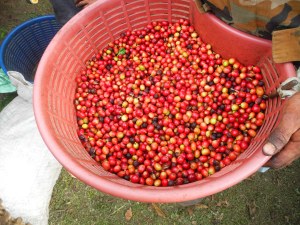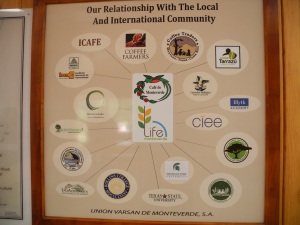
Over the last two weeks, I enjoyed a physically and spiritually restoring vacation in Costa Rica, which was particularly helpful for rekindling a connection to nature and its diverse ecosystems. In addition to rainforest canopy tours, volcano hikes, and surf lessons, one of the top highlights was a tour of the Life Monteverde coffee farm, in the north-central Costa Rican highlands. This organization brings together 12 families who have deep roots in the region, and jointly manage a 42-acre organic coffee farm. Since 2008, the group has also developed a multi-layered educational program, which each year engages over 1,000 tourists and sustainability and agricultural students from around the world.
As someone who has worked in sustainability for the past five years, mainly in the energy sector, I was particularly interested in learning how this concept has developed in a Central American, primarily agricultural context. While the sustainability field has become more standardized in recent years (e.g. through the UN Global Compact, Global Reporting Initiative, and ISO 14000 standards), it remains very diverse and relatively young. One of the exciting implications of this diversity is the ability to challenge previously-held “truths” and develop new approaches through cross-cultural learning.
As we strolled through rows of various crops, picked coffee beans alongside Nicaraguan field workers, and sipped the fruits of slow-drip coffee, I slowly realized that this particular farm – which in many ways advocates for the slow-food, back-to-the-roots agrarian movement – is actually at the vanguard of new approaches for promoting a more sustainable world.
Here are four ways in which our visit challenged some of my preconceived “sustainability truths”.
1. Sustainability doesn’t require new technology.
Like many forward-thinking organizations, the Life Monteverde farm has an ambitious goal to be carbon-neutral, and has already implemented several steps to achieve that goal. Unlike many of these other organizations, it has done so without spending money on radically new technologies. Perhaps owing to its agricultural roots and ecosystem, the farm has deployed some decidedly old-fashioned technology, but in new combinations to unlock opportunities to operate more efficiently.
Here are just two examples:
 One of the farm’s main activities is maintaining a herd of goats. These animals help provide milk for cheese – one of the farm’s increasingly diverse line of value-added ag products. Typically, preparing goat feed represents one of the most costly and energy-intensive parts of maintaining these animals. The Life Monteverde farm addresses this challenge by allowing goats to graze where possible, and using an old, human-powered bicycle to chop up supplemental feed, without requiring any electricity.
One of the farm’s main activities is maintaining a herd of goats. These animals help provide milk for cheese – one of the farm’s increasingly diverse line of value-added ag products. Typically, preparing goat feed represents one of the most costly and energy-intensive parts of maintaining these animals. The Life Monteverde farm addresses this challenge by allowing goats to graze where possible, and using an old, human-powered bicycle to chop up supplemental feed, without requiring any electricity.
 Another typically high cost is the gas required to power coffee roasting ovens and the residences where workers and guests cook meals (and of course, drink coffee). Here again, the farm benefits from thinking holistically about its agricultural ecosystem: it mixes its pigs’ manure with water that flows downhill to fertilize much of the farm’s crops. The remaining manure mixture is then collected by a biodigester, which is conveniently positioned directly downhill form the pig kennels. This low-tech contraption essentially consists of a small pond with bacteria, covered by a tent that captures methane gas, and a small piping system to transport the gas to the roasters and residential facilities.
Another typically high cost is the gas required to power coffee roasting ovens and the residences where workers and guests cook meals (and of course, drink coffee). Here again, the farm benefits from thinking holistically about its agricultural ecosystem: it mixes its pigs’ manure with water that flows downhill to fertilize much of the farm’s crops. The remaining manure mixture is then collected by a biodigester, which is conveniently positioned directly downhill form the pig kennels. This low-tech contraption essentially consists of a small pond with bacteria, covered by a tent that captures methane gas, and a small piping system to transport the gas to the roasters and residential facilities.
Through a holistic understanding of all the resources available in the farm’s ecosystem and intelligent design, Life Monteverde has been able to use old, low-cost technology to make a significant dent in its energy use.
2. Sustainability standards can serve as gateways, without being the ultimate solution.
One of my keen interests in visiting Life Monteverde was to hear about the impact of international Fair Trade certification on its ability to access a fair price for its products. In many of our food supply chains, the middlemen and retailers reap most of the profits from what consumers pay, while the original farmers (often in poorer countries) only earn cents on the dollars of what they produce. For crops such as coffee, chocolate, sugar, and many fruits, those farmers are typically in poorer countries to begin with, and these supply chains lock in a continual system of poverty that is passed on from generation to generation. A world-wide campaign led by Fair Trade International seeks to certify farms where the initial producers are paid a fairer wage, thereby making it easier for socially conscious retailers and consumers to support a more equitable supply chain. As full disclosure, an organization that I volunteer for, Engineers Without Borders Calgary, is actively supporting a campaign to make our city Fair Trade-certified.
The farmers at Life Monteverde provided an interesting, nuanced version of Fair Trade certification. The farm earned certification in previous years, which helped it form relationships with coffee shops and retailers in industrialized countries looking to support the movement. Recently, however, it viewed the costs of renewing certification as more burdensome than the benefits it received – particularly since it had already established successful relationships with socially conscious businesses. Additionally, obtaining certification entails some specific governance arrangements that ran counter to the farm’s desire to become a more family-run business. For those reasons, Life Monteverde no longer views Fair Trade certification as necessary to its continued success. However, obtaining this standard in years past served as a useful gateway by helping the farm access markets that paid a fair wage for its products – even if the farm now has the capacity to nurture these relationships on its own.
3. “Shock therapy” can be an effective teaching method for sustainability.
Much sustainability research focuses on encouraging behaviour change, whether that entails consumers adopting more energy efficient behaviours, companies changing their business practices, or governments adopting new policies. Often, the thinking I’m exposed to presents this as a slow process that seeks to gradually change a particular agent’s current paradigm, often without their explicit knowledge. For example, the Obama Administration explored the concept of “nudging” consumers towards better decisions through changing the default options they faced (e.g. automatically considering drivers organ donors unless they specifically opt out).

The fruits of seven tourists picking coffee beans for 15 minutes – less than what one farmhand can pick in the same amount of time.
While much of our visit to Life Monteverde was conducted through a conventional tour format, by far the most impactful learning occurred when our group was suddenly told to start picking coffee beans alongside the regular farmhands. We each were handed a bushel, given some simple instructions on how to pick the ripe, red beans, and sent to work in rows between the mostly Nicaraguan workers. This was a truly transformative part of the tour. It is one thing to discuss the finer points of fair wages and supply chains while sipping coffee, but there is no more visceral understanding of power, privilege, and fairness than when you are working side-by-side with the coffee pickers themselves, and then have the luxury of stopping after about 15 minutes and carrying on with the rest of your day. It is also a humbling experience; after our brief stint, my calves were trembling from the constant squatting, yet we were informed that most pickers work 12-13 hours at a time, and must carry 50-kg bags of beans to be counted at the end of their shift. This completely changed the frame through which I viewed the coffee supply chain: even the $35 daily salary for coffee pickers – which apparently is high enough to qualify for Fair Trade certification – seemed unfairly low.
4. Sustainability can be “scaled” without expanding size, but by expanding networks.
A central assumption at the heart of almost any sustainability venture is the desire to “scale up” by expanding the size of a program or organization: a new sustainable business can have a larger impact if it increases the number of employees and customers, while a successful sustainability program at a large corporation should grow to cover the whole business. But curiously, Life Monteverde has increased their sustainability practices by going smaller. While the farm used to be part of a larger cooperative, it recently downsized to include just a dozen families that share a similar desire to promote sustainability and agricultural education.

The web of partnerships that Life Monteverde has nurtured.
However, in many ways, the organization has continued to increase its impact while shrinking in membership. It has done so by expanding the scope of its partnerships with like-minded organizations around the world, including U.S. universities that send students each year to work on the farm’s projects, to Italian non-governmental organizations that expand brand awareness of the farm’s products in Europe. In many ways, Life Monteverde offers its operation as a real-world laboratory for other organizations to refine and share their own approaches to sustainability; many of the farm’s sustainable features started as student projects.
Ultimately, the farm’s managers believe, forming relationships throughout the world with like-minded groups is the key to creating an improved, more sustainable food system.



A good reminder that sustainability is more a journey than a destination. btw, where can one buy their product in Canada? Buying sustainably made products is another step on the journey…
LikeLiked by 1 person
Thanks Peter for reading, and agreed – it seems like sustainability can even be a circular journey at times! And thanks for the reminder on how consumers can support this farm. I believe they mentioned on our tour that they sell to Kicking Horse Coffee (kickinghorsecoffee.com) – my sense is that a lot of small sustainability-minded farmers end up being aggregated through bigger socially-minded brands like these.
More generally, Fair Trade Canada has a helpful list of where one can find Fair Trade certified products in Canada (http://www.fairtrade.ca/en-ca/buying-fairtrade), and Fair Trade Calgary does the same for our city (http://www.fairtradecalgary.com/fair-trade-goods.html). Again, acknowledging that this is but one step along the sustainability journey!
LikeLike